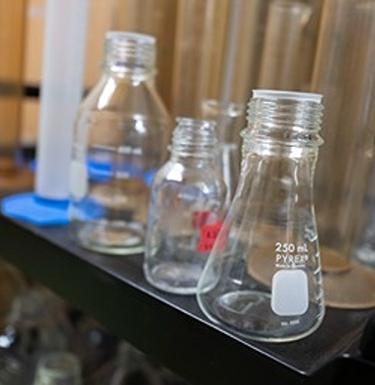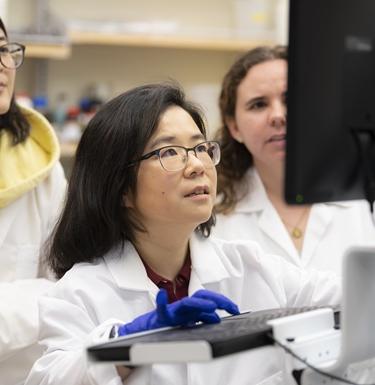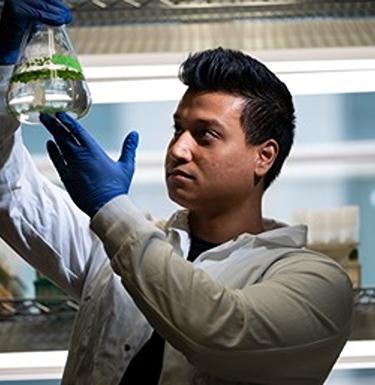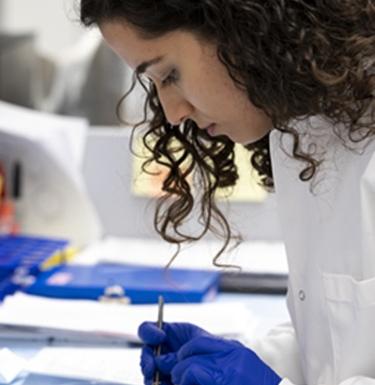
Several research groups in Chemical Biology are tackling highly complex biological systems by designing experiments that give unambiguous information even though the system is complex. Important tools used by several of these groups are selective drugs and selective analytical tools, as well as computational methods.

Computational & Theoretical Our Department features six research groups in Computational and Theoretical Chemistry that are involved in a diverse range of research topics including nanomaterials, biological processes, organic reaction mechanisms, and the electronic and optical properties of molecules and clusters. Our groups have combined expertise in quantum chemistry, molecular dynamics and Monte Carlo simulations, machine learning, rare-event sampling, and coarse-graining methods.
We are leaders in developing open-source chemistry software, including the OpenBabel chemistry toolbox, Avogadro molecular editor and visualization tool, PISCES package for modeling excess electrons interacting with molecules and clusters, Polyquant package for carrying out systems with two or more quantum particles (e.g., positrons and electrons), and WESTPA software for weighted ensemble rare-event sampling.
Our research benefits from high-performance computational resources at the University’s Center for Research Computing. We also participate in a greater community of computational scientists, including the Pittsburgh Supercomputing Center, Pittsburgh Quantum Institute, Computational Modeling and Simulation PhD Program, and Joint CMU-Pitt PhD Program in Computational Biology.

Diversity-Oriented Synthesis represents the synthesis of relatively small libraries of organic molecules that are structurally more complex, have a greater variety of core structures, and possess richer stereochemical variations than those produced by traditional combinatorial chemistry.

Electrochemistry offers an unique opportunity to investigate a variety of chemical processes at interfaces. Several research groups in our department study the fundamentals and applications of electrochemistry, which creates interdisciplinary research areas that span chemistry, physics, biology, and material/nano sciences. We take advantage of the powerful electrochemical approach to synthesize and characterize novel polymer/nano materials and also develop sensor devices. For instance, the high sensitivity and selectivity of our electrochemical sensors allow for in-situ monitoring of biologically important molecules such as DNA, neurotransmitters, and drugs at trace level. We are also interested in understanding how electrons, ions, and molecules are transported at solid/liquid, liquid/liquid, and membrane interfaces. To answer these questions, we develop new electrochemical methods as well as control interfacial structures at the molecular level.

Increasing energy demands, both nationally and globally, are intensifying demands for efficient, clean energy sources. In our department, groups across divisions address this problem by synthesizing, characterizing, and modeling new materials for applications like solar energy conversion, carbon capture and sequestration, and efficient batteries.

From synthesis to physical measurement to theory, chemistry is at the core of the broad field of nanoscience. Many faculty members in the department of chemistry actively pursue cutting-edge Nanoscience research. All of these efforts involve collaborations not only between different groups in chemistry (analytical, biological, organic, inorganic, theory, and physical) but also leading researchers in various departments at Pitt including physics, engineering, biology, and medicine. Therefore, participating graduate students and postdocs develop a strong foundation in chemistry and benefit from an enriching multidisciplinary educational experience.

Natural product total synthesis provides a core component of many of the organic research programs. Natural product synthesis provides essential validation of newly developed reaction technologies, leads for developing new chemotherapeutic agents, and architectural inspiration for diversity-oriented synthesis. As a result, natural product synthesis is heavily integrated with medicinal and combinatorial chemistry as well as the traditional organic chemistry disciplines.

Essential processes of life are mediated by enzymes contained within protein complexes and cellular membranes. Several research groups in Protein Biophysics are trying to understand the structural and functional aspects of these critically important molecular assemblies. A significant and poorly understood phenomenon is that of protein folding. Researchers are using Raman spectroscopic measurements, computational approaches, and novel methods of showing how to measure distance changes occurring within enzymes and between proteins in complexes, all to tackle this problem. Computational work is also exploring a key question of how intermolecular interactions, for example a receptor and its agonist, alter the structure of the molecular assembly. Another important question is how protein structure is altered by its association with a cell membrane.

Spectroscopy is the method of choice in the determination of structure and function in chemical systems. Beyond the usual array of spectroscopic instrumentation (NMR, ESR, microwave, IR and Raman, UV/VIS, fluorescence, and X-Ray), many research groups in the Department are involved in the development of new methods of characterization and analysis of molecules in the gas and condensed phases. These include the development of nanostructures for optical sensing of chemical and biological transformations, determinations of the structures and dynamical properties of biologically relevant molecules using high resolution lasers, development of high resolution gas-phase separations of proteins and peptides based on ion mobility spectrometry, measuring distance constraints between two units on a macromolecule using pulsed ESR methods, new forms of spectroscopy for the detection of protein folding in real time, femtosecond laser studies of metal surfaces and semiconductor interfaces, and ab initio computations for the prediction of spectra and chiroptical phenomena in complex systems.

